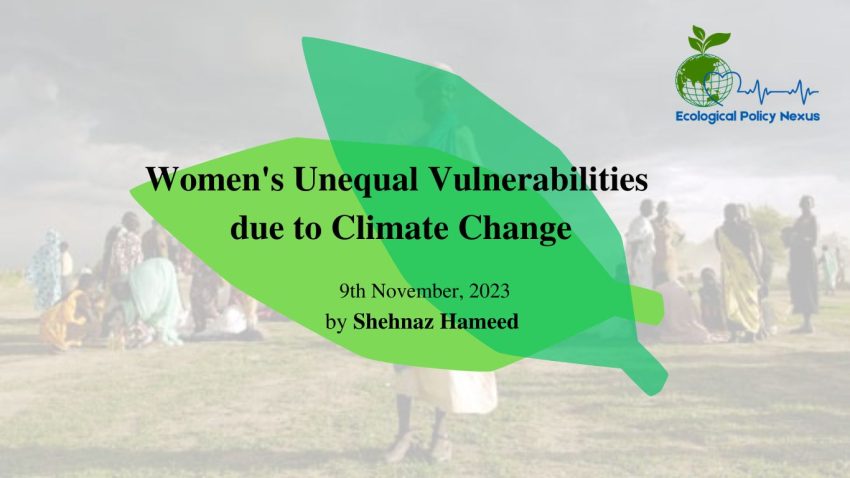by Shehnaz Hameed
Women fighting prejudice and discrimination has been seen in the history of humankind. But nobody imagined that this social issue would expand its grasp into the environmental domain and create more vulnerability for women. Scientists, policymakers, and researchers, after many years of hard and intensive studies, have established a crucial correlation between gender inequality and climate change. The research shows that the greatest global challenge of climate change threatens women more than men, amplifying the existing gender inequality. Climate change poses a threat to the health, livelihood, safety, and security of many women and girls around the world.
Women’s health is highly vulnerable to climate change as natural disasters and extreme weather conditions which are an example of climate change limit women’s access to health services and facilities. This creates health complications for women during deliveries and other maternal-related health problems. Natural catastrophes such as floods sweep away people’s houses and belongings; women lose access to sanitary pads and do not receive any assistance related to menstrual hygiene as part of the relief packages. As per UNFPA statistics, more than 26 million girls and women of menstruating age are displaced globally and the majority of them struggle to access basic menstrual hygiene supplies, menstrual health information, and health facilities to treat menstrual infections and diseases(UNFPA, 2021). The heat waves which are growingly observed in many places also increase the chances of women’s death and stillbirth during deliveries. Climate change, through its different phenomena, intensifies the spread of diseases such as malaria, dengue, fever, and zika virus which is responsible for worse maternal outcomes.
In many low to middle-income countries around the world, women take higher responsibility for securing food and water as they dominate the workforce in the agriculture sector. During droughts, heavy storms, and rainfall, women must work harder to secure crop production and sustain their source of income for their families. This overburdens women and especially school-going girls often miss school to help their mothers with the additional workload. Women are also most likely to be disproportionately affected by the aftermath of disasters due to a lack of information, mobility, and access to training. According to UNDP, women and children are 14 times more likely than men to die when a natural disaster hits( Okai Asako, 2022).
Climate change does not only escalate environmental problems but also social and political conflicts which lead to climate migrations. For instance, Sudan civil war is described as a climate change-induced conflict where 3.2 million people were displaced (MCOFSudan 2019 – international organization for migration 2019). Countries that shared watersheds such as Pakistan and India, Tajikistan and Kyrgyzstan, and many other nations where rivers run across the bounders have been involved in conflicts. According to World Bank, there would be estimated more than 216 million climate migrants in six regions of the world by 2050 (The World Bank, 2021), and 80% of the people displaced worldwide annually are women (Habtezion, 2016). As women seek safe havens far in strange lands amidst the climate crisis, women pay a price during this survival process in the form of gender-based violence. The violence includes not but is not limited to human trafficking, sexual violence, and child marriages.
Although climate change is not a gender-neutral challenge on a global scale, the impact varies in the geographical and regional context. Women in remote and rural areas bear more vulnerabilities than in urban areas or cities. Similarly, women in struggling economies are more prone to gender inequality posed by climate change than women in developed countries. This indicates that climate change is severe to women belonging to remote areas, indigenous and marginalized groups, women who are disabled, migrants, and who live in conflicted regions.
Given all these life-threatening vulnerabilities towards women, what can be done so that women do not lose their lives to global challenges such as climate change? How can we ensure the safety of women amidst climate catastrophes? There is no one answer to these questions but numerous. Removing these problems from the roots means fighting their root cause which itself is gender inequality. Women should be freed from the social constraints that stop them from getting educated, informed, skillful, trained, and empowered to make decisions and protect themselves during the climate crisis. In areas where women’s education is restricted by cultural norms or financial challenges, the government should organize training to educate women about safety measures and disaster response. Governments and NGOs must also include sanitary pads and other menstrual hygiene essentials in the relief package and government aid. Let’s not forget that humans, regardless of gender, are equally responsible for causing climate change and thus it is unfair to let the burden of its repercussions fall only on the shoulders of women.
References:
- International Organization for Migration. (2019). MCOFSudan 2019 – international organization for migration. International Organization for Migration, Sudan . Retrieved March 8, 2023, from https://www.iom.int/sites/g/files/tmzbdl486/files/our_work/DOE/MCOF/MCOF-SUDAN-2017-2019_5.5mb.pdf
- Javed , M. (2022, September 14). Delivering sanitary kits to flood-hit women. The Express Tribune. Retrieved March 8, 2023, from https://tribune.com.pk/story/2376663/lending-a-helping-hand-delivering-sanitary-kits-to-flood-hit-women
- Pakistan , U. N. F. P. A. (2022, September 21). Women and girls in Pakistan need urgent health and protection services amid epic flood disaster – Pakistan. ReliefWeb. Retrieved March 8, 2023, from https://reliefweb.int/report/pakistan/women-and-girls-pakistan-need-urgent-health-and-protection-services-amid-epic-flood disaster#:~:text=Over%2030%20million%20people%20have,need%20of%20urgent%20health%20services.
- UNFPA Asiapacific. (2021, May 27). Menstruation maters. UNFPA Asiapacific. Retrieved March 8, 2023, from https://asiapacific.unfpa.org/en/mhm-photostory

